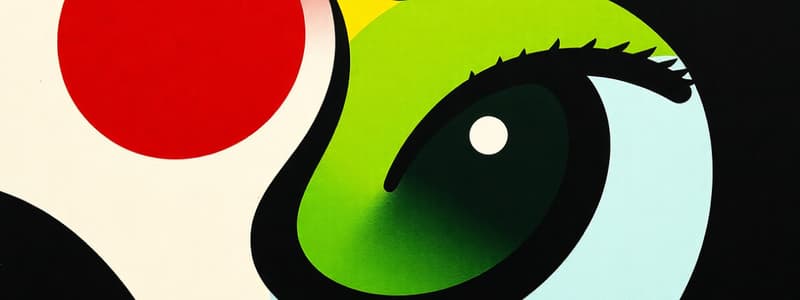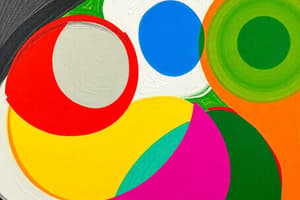Podcast
Questions and Answers
Which of the following is an example of a binocular cue that humans use to perceive depth?
Which of the following is an example of a binocular cue that humans use to perceive depth?
- Motion parallax
- Shading and contour
- Relative size of objects
- Retinal disparity (correct)
Which of the following describes the concept of convergence in visual perception?
Which of the following describes the concept of convergence in visual perception?
- The difference in images between the two eyes
- The extent to which the eyes turn inward when looking at an object (correct)
- The brain's ability to account for motion when perceiving depth.
- The relative size of objects
What type of visual cue is relative size?
What type of visual cue is relative size?
- Motion cue
- Monocular cue (correct)
- Depth cue
- Binocular cue
How does interposition contribute to depth perception?
How does interposition contribute to depth perception?
In the context of visual perception, what does motion parallax refer to?
In the context of visual perception, what does motion parallax refer to?
What is the definition of shape constancy?
What is the definition of shape constancy?
Which of the following best describes color constancy?
Which of the following best describes color constancy?
What is the primary function of hearing adaptation?
What is the primary function of hearing adaptation?
What is the role of proprioception in sensory perception?
What is the role of proprioception in sensory perception?
How does sensory adaptation affect our perception of stimuli?
How does sensory adaptation affect our perception of stimuli?
According to Weber's Law, what determines the just noticeable difference (JND)?
According to Weber's Law, what determines the just noticeable difference (JND)?
What is the definition of absolute threshold of sensation?
What is the definition of absolute threshold of sensation?
Which of the following stimuli would be considered subliminal?
Which of the following stimuli would be considered subliminal?
Which of the following is NOT a type of somatosensation?
Which of the following is NOT a type of somatosensation?
How do neurons encode the intensity of a somatosensory stimulus?
How do neurons encode the intensity of a somatosensory stimulus?
What key structure in the inner ear is responsible for detecting balance and spatial orientation?
What key structure in the inner ear is responsible for detecting balance and spatial orientation?
What is the role of endolymph within the semicircular canals?
What is the role of endolymph within the semicircular canals?
In the context of signal detection theory, what is a 'false alarm'?
In the context of signal detection theory, what is a 'false alarm'?
What is the main difference between bottom-up and top-down processing?
What is the main difference between bottom-up and top-down processing?
Which Gestalt principle suggests that similar items are grouped together by the brain?
Which Gestalt principle suggests that similar items are grouped together by the brain?
Which scenario best illustrates the concept of size constancy?
Which scenario best illustrates the concept of size constancy?
What is the primary role of the endolymph within the semicircular canals of the inner ear?
What is the primary role of the endolymph within the semicircular canals of the inner ear?
How does the visual cue of 'relative height' contribute to depth perception?
How does the visual cue of 'relative height' contribute to depth perception?
In signal detection theory, what does the term 'd-prime' (d') represent?
In signal detection theory, what does the term 'd-prime' (d') represent?
Which of the following accurately describes the concept of 'Weber's Law'?
Which of the following accurately describes the concept of 'Weber's Law'?
What is the significance of Calcium Carbonate (CaCO3) crystals in the otolithic organs?
What is the significance of Calcium Carbonate (CaCO3) crystals in the otolithic organs?
Which of the following is an example of sensory adaptation related to sight?
Which of the following is an example of sensory adaptation related to sight?
How do fast-adapting neurons encode the timing of a somatosensory stimulus?
How do fast-adapting neurons encode the timing of a somatosensory stimulus?
In the context of visual perception, what does retinal disparity refer to?
In the context of visual perception, what does retinal disparity refer to?
Which Gestalt principle explains why we tend to see a series of dots arranged in a line as a single, continuous line?
Which Gestalt principle explains why we tend to see a series of dots arranged in a line as a single, continuous line?
What does proprioception enable an individual to do?
What does proprioception enable an individual to do?
Which of the following is the best example of the Gestalt principle of 'closure'?
Which of the following is the best example of the Gestalt principle of 'closure'?
How do otolithic organs contribute to the sense of balance?
How do otolithic organs contribute to the sense of balance?
According to the provided content, what is the 'absolute threshold of sensation'?
According to the provided content, what is the 'absolute threshold of sensation'?
What is the primary difference between 'inductive reasoning' and 'deductive reasoning' in the context of top-down processing?
What is the primary difference between 'inductive reasoning' and 'deductive reasoning' in the context of top-down processing?
Which of the following scenarios best illustrates 'motion parallax'?
Which of the following scenarios best illustrates 'motion parallax'?
What is the role of context in the perception of stimuli?
What is the role of context in the perception of stimuli?
In signal detection theory, what is meant by adopting a 'conservative strategy'?
In signal detection theory, what is meant by adopting a 'conservative strategy'?
How is the intensity of a somatosensory stimulus encoded by neurons?
How is the intensity of a somatosensory stimulus encoded by neurons?
Flashcards
Visual cues
Visual cues
Inferences made when looking at something involves cues like depth, form, motion, and constancy.
Binocular cues
Binocular cues
Depth cues requiring two eyes; gives humans a sense of depth.
Retinal disparity
Retinal disparity
Eyes are ~2.5 inches apart, providing slightly different world views, giving humans an idea on depth.
Convergence
Convergence
Signup and view all the flashcards
Monocular Cues
Monocular Cues
Signup and view all the flashcards
Relative Size
Relative Size
Signup and view all the flashcards
Interposition
Interposition
Signup and view all the flashcards
Relative Height
Relative Height
Signup and view all the flashcards
Shading and Contour
Shading and Contour
Signup and view all the flashcards
Motion Parallax
Motion Parallax
Signup and view all the flashcards
Constancy
Constancy
Signup and view all the flashcards
Size Constancy
Size Constancy
Signup and view all the flashcards
Shape Constancy
Shape Constancy
Signup and view all the flashcards
Color Constancy
Color Constancy
Signup and view all the flashcards
Sensory Adaptation
Sensory Adaptation
Signup and view all the flashcards
Hearing adaptation
Hearing adaptation
Signup and view all the flashcards
Touch Adaptation
Touch Adaptation
Signup and view all the flashcards
Smell Adaptation
Smell Adaptation
Signup and view all the flashcards
Proprioception
Proprioception
Signup and view all the flashcards
Down regulation
Down regulation
Signup and view all the flashcards
Just Noticeable Difference (JND)
Just Noticeable Difference (JND)
Signup and view all the flashcards
Weber's Law
Weber's Law
Signup and view all the flashcards
Absolute Threshold of Sensation
Absolute Threshold of Sensation
Signup and view all the flashcards
Subliminal Stimuli
Subliminal Stimuli
Signup and view all the flashcards
Types of Somatosensation
Types of Somatosensation
Signup and view all the flashcards
Timing (of Neuron Encoding)
Timing (of Neuron Encoding)
Signup and view all the flashcards
Vestibular System
Vestibular System
Signup and view all the flashcards
Signal Detection Theory
Signal Detection Theory
Signup and view all the flashcards
Hit (Signal Detection)
Hit (Signal Detection)
Signup and view all the flashcards
False Alarm (Signal Detection)
False Alarm (Signal Detection)
Signup and view all the flashcards
Bottom-up Processing
Bottom-up Processing
Signup and view all the flashcards
Top-down Processing
Top-down Processing
Signup and view all the flashcards
Gestalt Principles
Gestalt Principles
Signup and view all the flashcards
Similarity (Gestalt)
Similarity (Gestalt)
Signup and view all the flashcards
Pragnanz
Pragnanz
Signup and view all the flashcards
Proximity (Gestalt)
Proximity (Gestalt)
Signup and view all the flashcards
Continuity (Gestalt)
Continuity (Gestalt)
Signup and view all the flashcards
Closure (Gestalt)
Closure (Gestalt)
Signup and view all the flashcards
Symmetry
Symmetry
Signup and view all the flashcards
Contextual Effects
Contextual Effects
Signup and view all the flashcards
Study Notes
Visual Cues
- Visual cues allow perceptual organization, considering depth, form, motion, and constancy
- Inferences are made when looking at something
- Binocular cues use two eyes to perceive depth
- Retinal disparity results from eyes being ~2.5 inches apart, providing slightly different views for depth perception
- Convergence informs depth perception based on eyeball muscle strain
- Relaxed eye muscles indicate distant objects
- Contracted eye muscles indicate close objects
- Monocular cues require only one eye for visual stimuli received
- Relative size: Closer objects appear larger, indicating form
- Interposition (overlap): Overlapping objects are perceived as being in front
- Relative height: Higher objects are perceived as farther away
- Shading and contour: help with perceiving form, depth, and contours utilizing light and shadows
- Motion parallax ("relative motion"): Farther objects appears to move slowly, closer objects appear to move faster. Gives sense of motion
- Constancy: perceiving objects as the same even when the image cast on the retina changes
- Size Constancy: Perceiving objects as the same size regardless of distance
- Shape Constancy: Perceiving objects as the same shape even if the shape we see changes
- Example: A door opening its shape is changing... still believe the door is a rectangle
- Color Constancy: Perceiving objects as the same color despite changes in lighting
Sensory Adaptation
- Sensory adaptation adapts sensitivity to stimuli
- Hearing adaptation: Inner ear muscles contract in response to high noise, dampening vibrations and protecting the eardrum; ineffective for sudden loud noises
- Touch: Temperature receptors desensitize over time
- Smell: Receptors desensitize to molecule sensory information over time
- Proprioception: Sense of body position in space i.e. "sense of balance/where you are in space"
- Experiment use goggles to make everything upside down for the perception of the world, and eventually will accommodate over time, and flip it back over
- Sight
- Down regulation: Light adaptation causes pupils to constrict, desensitizing rods and cones during bright light exposure
- Up regulation: Dark regulation causes pupils to dilate. rods and cones synthesizing light sensitive molecules
Weber's Law
- Just noticeable difference (JND) refers to the threshold for detecting a change in sensation
- Weber's Law : ΔI (JND) / I (initial intensity) = k (constant)
- Example: 0.2/2 = 0.5/5 = 0.1, change must be 0.1 of initial intensity to be noticeable
- Weber’s Law predicts a linear relationship between incremental threshold and background intensity
- ΔI = Ik
- Plotting shows I against ΔI is constant
Absolute Threshold of Sensation
- Absolute threshold of sensation is the minimum stimulus intensity required for detection 50% of the time
- Detection can vary between individuals at low stimulus levels
- Absolute threshold is related to but distinct from the difference threshold (JND)
- Psychological states can influence the absolute threshold
- Expectations (Are you expecting a text?)
- Experience (How familiar are you with vibration sound)
- Motivation (Are you interested in the text response)
- Alertness (Are you awake our drowsy)
- Subliminal stimuli are below the absolute threshold
Somatosensation
- Somatosensation receives information regarding intensity, timing, and location of stimuli
- Includes sensing temperature (thermoception), pressure (mechanoception), pain (nociception), and position (proprioception)
- Intensity is determined by neuron firing rate
- Slow firing implies low intensity
- Fast firing implies high intensity
- Timing involves three patterns of neuron encoding
- Non-adapting: Consistent firing rate
- Slow-adapting: Slower firing rate to stimulus
- Fast-adapting: Firing at stimulus onset, stopping, then restarting when stimulus changes
- Location specific stimuli relies on dermatomes and is sent to the brain by nerves
The Vestibular System
- The vestibular system controls balance and spatial orientation
- Input comes from both the inner ear and limbs
- Semicircular canals in the inner ear which are posterior, lateral and anterior detect head rotation
- Endolymph fluid shifts in the semicircular canals enabling the detection of head direction and rotation strength
- Otolithic organs (utricle and saccule) detect linear acceleration and head positioning
- CaCO3 crystals attached to hair cells in viscous gel trigger an action potential and move when transitioning between laying down and standing up.
- Dizziness and vertigo can occur when endolymph continues to move
Signal Detection Theory
- Signal detection theory studies decision-making under uncertain conditions, differentiating between important stimuli and noise
- Considered discerning between important stimuli and unimportant stimuli ("noise")
- Origins come from sonar- detecting small fish vs large whale
- Considers hits, misses, false alarms, and correct rejections
- Hit: Affirmative response to a present signal
- False Alarm: Signal perceived when absent
- Correct Rejection: Correctly identifies the absence of a signal
- Miss: Failure to respond to a present signal
- *Note: This is different terminology to Type I / Type II errors
- Signal Strength (d') is variable
- hit > miss (when there is a strong signal)
- miss > hit (weak signal)
- Strategy of signal detection (c)
- Conservative strategy: Never affirm unless certain, leading to fewer false alarms and potential misses
- Or Liberal strategy: Always affirm, leading to more true positives and potential false alarms
Studying That Suits You
Use AI to generate personalized quizzes and flashcards to suit your learning preferences.




